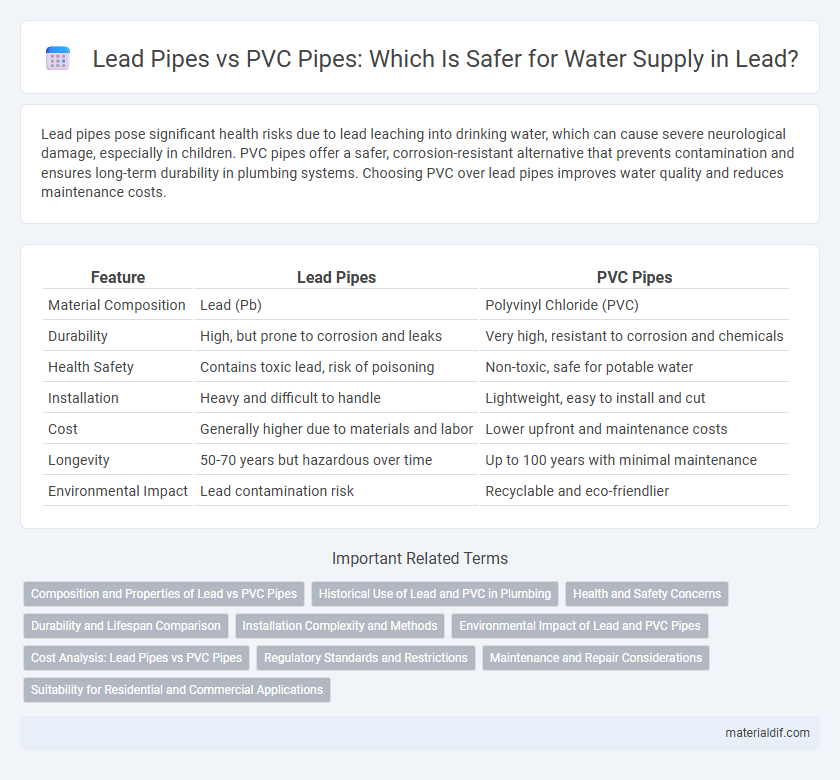Lead pipes pose significant health risks due to lead leaching into drinking water, which can cause severe neurological damage, especially in children. PVC pipes offer a safer, corrosion-resistant alternative that prevents contamination and ensures long-term durability in plumbing systems. Choosing PVC over lead pipes improves water quality and reduces maintenance costs.
Table of Comparison
| Feature | Lead Pipes | PVC Pipes |
|---|---|---|
| Material Composition | Lead (Pb) | Polyvinyl Chloride (PVC) |
| Durability | High, but prone to corrosion and leaks | Very high, resistant to corrosion and chemicals |
| Health Safety | Contains toxic lead, risk of poisoning | Non-toxic, safe for potable water |
| Installation | Heavy and difficult to handle | Lightweight, easy to install and cut |
| Cost | Generally higher due to materials and labor | Lower upfront and maintenance costs |
| Longevity | 50-70 years but hazardous over time | Up to 100 years with minimal maintenance |
| Environmental Impact | Lead contamination risk | Recyclable and eco-friendlier |
Composition and Properties of Lead vs PVC Pipes
Lead pipes consist primarily of elemental lead, a dense, malleable metal resistant to corrosion but prone to leaching harmful lead ions into drinking water. PVC pipes are made from polyvinyl chloride, a lightweight, durable thermoplastic polymer known for its chemical resistance, flexibility, and non-toxic nature in potable water applications. While lead pipes offer longevity and corrosion resistance, PVC pipes provide superior safety, easier installation, and lower maintenance due to their inert composition and resistance to scale buildup.
Historical Use of Lead and PVC in Plumbing
Lead pipes were widely used in plumbing from ancient Roman times through the early 20th century due to their malleability and durability, despite known health risks from lead poisoning. PVC pipes emerged in the mid-20th century as a safer, more cost-effective alternative, offering chemical resistance and ease of installation without the toxicity associated with lead. The transition from lead to PVC marked a significant advancement in plumbing materials, enhancing public health and system longevity.
Health and Safety Concerns
Lead pipes pose significant health risks due to the potential leaching of toxic lead into drinking water, which can cause neurological damage and developmental issues, especially in children. PVC pipes offer a safer alternative as they do not corrode or release harmful substances, ensuring cleaner water quality and reducing the risk of lead poisoning. Regulatory agencies strongly recommend replacing lead pipes with PVC or other non-toxic materials to enhance public health and safety.
Durability and Lifespan Comparison
Lead pipes, historically used for water supply, often corrode and degrade over time, leading to reduced lifespan and potential health risks, typically lasting around 50-70 years under ideal conditions. PVC pipes, made from polyvinyl chloride, exhibit superior durability with resistance to corrosion, chemicals, and biofilm buildup, enabling a lifespan exceeding 100 years in most environments. The durability difference makes PVC the preferred choice for modern plumbing, offering long-term reliability and lower maintenance costs.
Installation Complexity and Methods
Lead pipes require specialized skills for installation due to their heavy weight and the need for precise soldering techniques to ensure watertight joints, often necessitating professional plumbers familiar with lead handling and safety precautions. In contrast, PVC pipes offer straightforward installation with lightweight materials and solvent cement joining methods that are quicker and easier, allowing for more DIY-friendly applications and reduced labor costs. The complexity of installing lead pipes also stems from regulatory restrictions and the need for protective equipment to mitigate lead exposure risks, unlike PVC pipes, which pose minimal health concerns during installation.
Environmental Impact of Lead and PVC Pipes
Lead pipes release toxic heavy metals into soil and water, causing severe environmental pollution and health risks such as neurological damage in humans and wildlife. PVC pipes, while less toxic, contribute to environmental concerns through the release of harmful chemicals like phthalates and dioxins during production and disposal. Sustainable alternatives emphasize low-toxicity materials to minimize contamination and ecological harm associated with traditional piping systems.
Cost Analysis: Lead Pipes vs PVC Pipes
Lead pipes typically have higher initial costs due to material expenses and labor-intensive installation processes, whereas PVC pipes are generally more cost-effective with lower manufacturing and installation costs. Over the long term, PVC pipes offer significant savings by requiring less maintenance, reduced likelihood of leaks, and lower health-related remediation expenses compared to lead pipes. The overall cost analysis strongly favors PVC pipes for budget-conscious projects emphasizing durability and safety.
Regulatory Standards and Restrictions
Lead pipes are heavily regulated due to their toxicity and potential health risks, with many countries, including the United States and European Union, enforcing strict bans or limitations on their installation in drinking water systems. PVC pipes comply with regulatory standards such as NSF/ANSI 61 for safe potable water use, and are widely accepted as a safer alternative because they do not leach harmful substances. Compliance with these standards ensures that PVC piping systems meet health and environmental safety requirements, promoting their preferred use in modern plumbing infrastructure.
Maintenance and Repair Considerations
Lead pipes are prone to corrosion and require frequent inspection and specialized repairs to prevent serious health hazards. PVC pipes offer low maintenance with high resistance to corrosion and chemical damage, reducing repair frequency and costs. Choosing PVC over lead pipes minimizes ongoing maintenance challenges and extends the lifespan of plumbing systems.
Suitability for Residential and Commercial Applications
Lead pipes pose significant health risks due to lead leaching, making them unsuitable for residential and commercial water supply systems. PVC pipes offer superior corrosion resistance, chemical stability, and ease of installation, ideal for modern plumbing in homes and businesses. Regulatory standards increasingly favor PVC over lead, ensuring safer, more durable water distribution infrastructure.
Lead pipes vs PVC pipes Infographic

 materialdif.com
materialdif.com